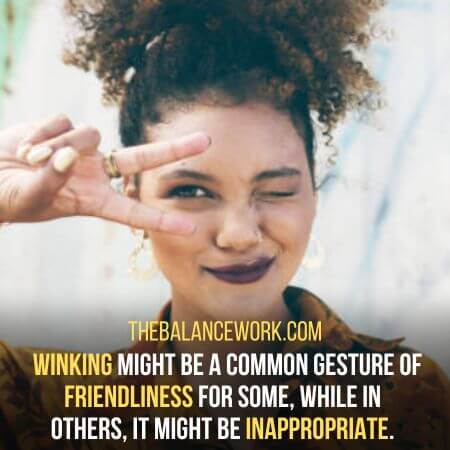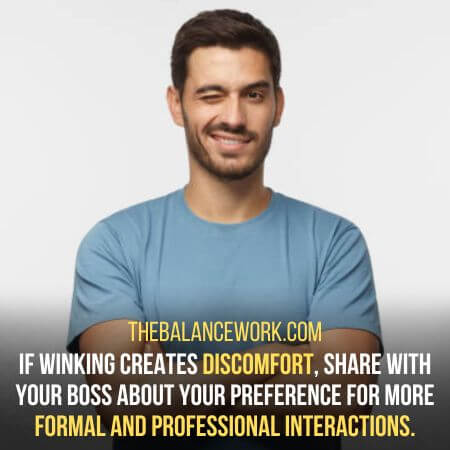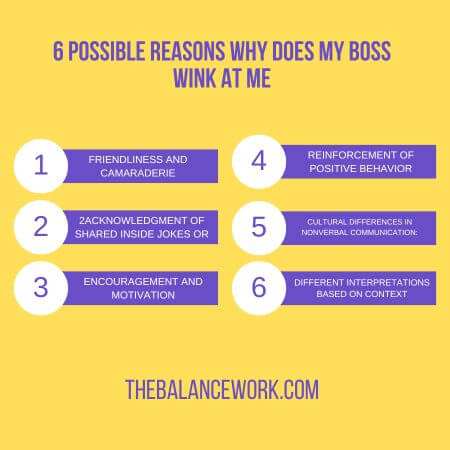Why Does My Boss Wink At Me? The reason when your boss winks at you can vary. It might signal friendliness, acknowledge shared understanding, or offer encouragement.
Evaluating the context and your relationship can help you decipher the intended meaning behind the wink and guide your response accordingly.
6 Possible Reasons Why Does My Boss Wink At Me
What does it mean when your boss winks at you? Interpreting the intention behind your boss’s winking requires a nuanced understanding of the diverse reasons that might motivate this nonverbal gesture.
Like all nonverbal communication, Winking can carry various meanings based on context, culture, and the existing relationship dynamics.
1. Friendliness And Camaraderie:
A boss’s winking might stem from a genuine desire to establish a friendly rapport with their employees.
Winking can signify an attempt to create a warm and approachable atmosphere within the workplace, contributing to a positive team dynamic.
Inside jokes or shared experiences can lead to moments of winking to acknowledge the camaraderie and mutual understanding within the team.
This can be a means of fostering a sense of belonging and inclusivity.
3. Encouragement And Motivation:
Winking can be a motivational tool to encourage employees to maintain their performance or exceed expectations.
It may indicate that the boss appreciates the team’s efforts and urges them to keep up the good work.
4. Reinforcement Of Positive Behavior Or Performance:
When a boss winks at an employee, it can subtly reinforce positive behaviors or acknowledge notable accomplishments.
This positive reinforcement can contribute to boosting employee morale and job satisfaction.
5. Cultural Differences In Nonverbal Communication:
Cultural norms and practices strongly influence nonverbal cues.
In some cultures, winking might be a common gesture of friendliness, while in others, it might be perceived as inappropriate or disrespectful.

Understanding the cultural background of your boss can provide insight into their intended message.
6. Different Interpretations Based On Context And Familiarity:
Context plays a crucial role in understanding the intent behind winking.
My boss winked at me to establish a light-hearted atmosphere during informal discussions, but the same gesture might not be appropriate in more serious settings.
Familiarity with the boss’s communication style and tendencies also plays a role in accurate interpretation.
In all cases, it’s essential to approach the situation with sensitivity and recognize the broader context.
An open-minded perspective can help employees navigate these interactions effectively while maintaining professionalism and respect.
If the intention behind the winking remains unclear or causes discomfort, initiating a conversation with the boss can clarify and ensure a healthy working relationship.
Consideration Of Your Relationship
Navigating nonverbal communication, such as winking from a boss, requires a thoughtful assessment of your relationship dynamics.
The nature of your rapport and comfort level with your boss can significantly influence how you interpret and respond to such gestures.
1. Evaluate The History Of Interactions And Dynamics:
Reflect on the past interactions you’ve had with your boss. Have they been predominantly formal, informal, or a mix of both?
Understanding the history of your interactions can shed light on the context in which the winking occurs.
2. Consider Your Perception Of Their Behavior Towards Others:
Observe how your boss interacts with other team members. Does their behavior, including nonverbal cues, differ when interacting with others?
This observation can help gauge whether the winking is consistent with their communication style.
3. Gauge Whether The Winking Behavior Is Consistent Or Recent:
Determine whether the boss winks at me behavior is something that has been ongoing or if it has recently emerged.
Consistency might indicate a specific communication style, while sudden changes could suggest shifts in dynamics.
Consider if you have shared experiences or conversations that might explain the winking.
Inside jokes, personal discussions, or mutual understanding could influence such gestures.
Professionalism And Boundaries:
My boss winks at me, which makes you uncomfortable. It’s important to acknowledge your feelings. Trust your instincts and explore the root of your discomfort.
It might be helpful to jot down specific instances and your feelings associated with them.
1. Worries About Favoritism Or Misinterpretation:
Winking, especially from a superior, can raise concerns about favoritism or misinterpreting intentions.
Clarify whether you feel the winking might lead to perceptions of bias within the team.
2. Communicate Your Preferences For Professional Interactions:
If the winking creates discomfort, consider candidly conversing with your boss about your preference for more formal and professional interactions.

This can help align expectations and set the tone for future communications.
3. Seek Clarity On Any Actions That Make You Uncomfortable:
If you believe setting boundaries is essential, address any specific actions that have made you uncomfortable.
This can be done respectfully and non–confrontational, focusing on your perspective and preferences.
Navigating this delicate balance requires a combination of self-awareness, effective communication, and the ability to set personal boundaries with professionalism.
It’s essential to remember that everyone’s comfort levels and perceptions of nonverbal cues can vary, so what works for one person might not work for another.
Handling Different Responses:
The boss winked at me gesture from your boss requires adept navigation of various possible scenarios.
How you respond largely depends on your interpretation of the intention behind the winking and your comfort level with such interactions.
1. If The Winking Is Intended Positively:
When interpreting a boss’s winking as a positive gesture, it’s essential to consider the context.
If it aligns with camaraderie or encouragement, reciprocating with professionalism while fostering rapport can be effective in maintaining a positive relationship.
Understand The Context And Continue Building Rapport:
If you perceive the winking as a positive gesture, it’s essential to consider the context in which it occurs.
If the winking aligns with moments of camaraderie, shared understanding, or encouragement, it may indicate a friendly and approachable boss.
In such cases, continue fostering the rapport by engaging in open and positive interactions.
Maintain Professionalism While Reciprocating Gestures:
While reciprocating gestures can be a way to build rapport, it’s crucial to do so while maintaining a professional demeanor.

Light-hearted responses, such as a smile or a subtle nod, can help establish camaraderie without compromising professional boundaries.
2. If The Winking Is Unintentional Or Misunderstood:
If the winking is unintentional or uncomfortable, respectfully address your feelings.
Express your appreciation for the approachability, but explain that you prefer a more formal communication style.
Reinforce your preference for professional interactions while acknowledging their positive intentions.
3. Maintain Respect While Redirecting The Dynamic:
If the winking was unintended or you feel it’s causing discomfort, navigating the situation without causing any awkwardness is important.
Redirect the dynamic by focusing on the content of the conversation rather than the nonverbal cues.
Maintain respect and professionalism throughout the interaction.
The key is open communication and the willingness to adapt while ensuring your comfort and professionalism.
Handling these sensitive responses can contribute to a healthy working relationship while preserving the balance between friendly interactions and professional boundaries.
Remember that perceptions and interpretations of nonverbal cues can vary among individuals.
What might be interpreted as positive by one person could be misinterpreted by another.
Keeping an open mind, being self-aware, and addressing situations with maturity can help foster positive interactions in the workplace.
Boss Winking At You And The Significance Of Nonverbal Communication
In the complex landscape of workplace dynamics, communication extends far beyond spoken words.
Nonverbal cues are pivotal in conveying messages, emotions, and intentions.
Facial expressions, body language, and gestures hold a special place among these cues.
One such gesture often raises questions is when a boss winks at an employee.
Understanding nonverbal communication and the potential implications of such gestures is crucial for fostering healthy professional relationships.
Nonverbal Communication
Nonverbal communication encompasses an array of unspoken signals that convey emotions, attitudes, and intentions.
It’s estimated that up to 93% of human communication is nonverbal, underscoring its significance in understanding the true meaning behind words.
Nonverbal cues build trust, establish rapport, and form impressions about others.
In a professional setting, these cues play a substantial role in influencing team dynamics and interpersonal relationships.
Various Forms Of Nonverbal Communication:
Nonverbal communication encompasses facial expressions, body language, and gestures.

These forms convey emotions, attitudes, and intentions, often complementing or contradicting spoken words to create a richer understanding of communication.
1. Facial Expressions:
The face is a canvas of emotions, reflecting happiness, surprise, anger, or confusion.
Smiles frowns, raised eyebrows, and narrowed eyes convey distinct messages that complement or contradict verbal communication.
2. Body Language:
Body language encompasses gestures, postures, and movements that reveal feelings or attitudes.
For instance, standing with arms crossed might indicate defensiveness or a lack of openness.
Maintaining an open posture can signal receptiveness and confidence.
3. Gestures:
Gestures involve movements of the hands and arms to emphasize, clarify, or emphasize points.
They can vary significantly across cultures, carrying different meanings or implications.
Interpreting Winking In Different Contexts:
Winking, a seemingly simple gesture, can carry various meanings based on the context and relationship.
In some cultures, winking is a playful and friendly gesture, often shared among friends.
It can indicate camaraderie, shared understanding, or even approval. However, in a professional context, its interpretation can vary widely.
The boss winks and smiles at me, which can be interpreted in several ways:
It might be an attempt to foster a friendly atmosphere, acknowledge a shared understanding, or convey a light-hearted moment.
Winking could be a motivational gesture, signaling approval of an accomplishment, or encouraging continued good work.
Personal traits and cultural norms can influence winking. What might be acceptable in one culture might be inappropriate or misinterpreted in another.
In all cases, understanding the broader context and relationship dynamics is crucial to accurately interpreting the intention behind the winking gesture.
Conclusion:
Handling different responses to your boss’s winking involves assessing your comfort level, understanding the context, and responding accordingly.
Whether the winking is intended positively or unintentionally, respectfully addressing your feelings and preferences is vital.
By navigating these interactions thoughtfully, you can contribute to a harmonious workplace atmosphere while upholding professionalism and personal boundaries.
- Why Does My Boss Wink At Me? 6 Potential Reasons - October 5, 2023
- Is It Legal For Your Employer To Call Your Doctor? No, But… - October 4, 2023
- 12 Ways To Deal With A Low IQ Person - September 22, 2023